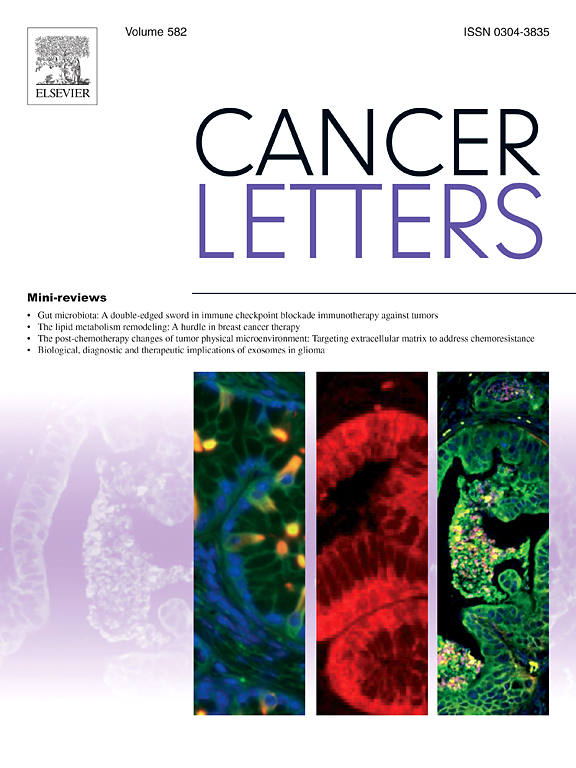肿瘤相关巨噬细胞来源的细胞外囊泡中的纤维蛋白原样2通过促进肿瘤干性和中性粒细胞细胞外陷阱的形成,在结直肠癌肝转移中形成免疫抑制微环境
IF 9.1
1区 医学
Q1 ONCOLOGY
引用次数: 0
摘要
研究结肠直肠癌肝转移(CRLM)中免疫抑制微环境发展的机制对于确定免疫治疗的协同靶点非常重要。肿瘤相关巨噬细胞衍生细胞外囊泡(tam - ev)在CRLM免疫微环境中的调节作用尚未得到充分探讨。在这里,我们发现tam - ev在小鼠CRLM模型的侵袭前沿形成免疫抑制微环境,从而抑制抗pd -1免疫治疗。这种环境的特点是增加肿瘤干性潜能和丰富的中性粒细胞胞外陷阱(NETs)的形成。在机制上,tam - ev衍生的纤维蛋白原样2 (FGL2)与肿瘤细胞中的FCGR2B受体相互作用,进一步激活p-STAT3/IL-1β正反馈回路,增加癌细胞的干性潜能,而IL-1β介导癌细胞与中性粒细胞之间的通信。使用抗il -1β单克隆抗体可以减少NETs的产生,并与抗pd -1免疫疗法协同作用,这对CRLM治疗具有临床转化意义。FGL2/p-STAT3/IL-1β环与人类CRLM患者的免疫抑制微环境和不良预后相关。我们的研究结果揭示了通过使用抗il -1β单克隆抗体靶向清除NETs来提高免疫治疗效果的潜力,这在治疗CRLM方面具有重要的临床转化价值。本文章由计算机程序翻译,如有差异,请以英文原文为准。
Fibrinogen-like 2 in tumor-associated macrophage-derived extracellular vesicles shapes an immunosuppressive microenvironment in colorectal liver metastases by promoting tumor stemness and neutrophil extracellular traps formation
Investigating the mechanisms underlying the development of an immunosuppressive microenvironment within colorectal liver metastases (CRLM) is important for identifying synergistic targets for immunotherapy. The regulatory role of tumor-associated macrophage-derived extracellular vesicles (TAM-EVs) in the immune microenvironment of CRLM has not yet been fully explored. Here, we found that TAM-EVs shaped the immunosuppressive microenvironment at the invasive front in murine CRLM models, thus dampening anti-PD-1 immunotherapy. This environment is characterized by an increased tumor stemness potential and abundant neutrophil extracellular traps (NETs) formation. Mechanistically, TAM-EVs-derived fibrinogen-like 2 (FGL2) interacts with the FCGR2B receptor in tumor cells, which further activates a p-STAT3/IL-1β positive feedback loop to increase the stemness potential of cancer cells, whereas IL-1β mediates the communication between cancer cells and neutrophils. The use of an anti-IL-1β monoclonal antibody can reduce NETs production and synergize with anti-PD-1 immunotherapy, which offers clinical translational significance for CRLM therapy. The FGL2/p-STAT3/IL-1β loop correlates with an immunosuppressive microenvironment and poor prognosis in human patients with CRLM. Our results revealed the potential of enhancing the efficacy of immunotherapy via the targeted clearance of NETs using anti-IL-1β monoclonal antibodies, which have significant clinical translational value in the treatment of CRLM.
求助全文
通过发布文献求助,成功后即可免费获取论文全文。
去求助
来源期刊

Cancer letters
医学-肿瘤学
CiteScore
17.70
自引率
2.10%
发文量
427
审稿时长
15 days
期刊介绍:
Cancer Letters is a reputable international journal that serves as a platform for significant and original contributions in cancer research. The journal welcomes both full-length articles and Mini Reviews in the wide-ranging field of basic and translational oncology. Furthermore, it frequently presents Special Issues that shed light on current and topical areas in cancer research.
Cancer Letters is highly interested in various fundamental aspects that can cater to a diverse readership. These areas include the molecular genetics and cell biology of cancer, radiation biology, molecular pathology, hormones and cancer, viral oncology, metastasis, and chemoprevention. The journal actively focuses on experimental therapeutics, particularly the advancement of targeted therapies for personalized cancer medicine, such as metronomic chemotherapy.
By publishing groundbreaking research and promoting advancements in cancer treatments, Cancer Letters aims to actively contribute to the fight against cancer and the improvement of patient outcomes.
 求助内容:
求助内容: 应助结果提醒方式:
应助结果提醒方式:


